As you’ll understand if you read my original Gaggia classic review, I’m truly fond of the Gaggia Classic – as a number of people are, but I’d been less impressed by more current iterations of the classic, so when they released the new Gaggia Classic pro, obviously I was extremely keen to get my hands on one.
So I jumped in my car, and drove to Gaggia Direct, to pick up the Classic pro, also called the Gaggia Classic 2019 (even though it is of course 2022, but 2019 is when it was first planned for release), and this review article is the result.
Actually a quick note re Gaggia Direct – as I mention later on. on in this post, Gaggia Direct are the UK stockist for Gaggia Milan. They’re in the UK, near Halifax, it’s all UK stock, they have service engineers who sort all of the warranty stuff, and you’re in good hands with these guys when it comes to after-sales service and support.
Just keep in mind if you’re hunting for the best price, if you find a better price for the Classic Pro, it’s more than likely a grey import. It may look like you’re buying from a UK firm, however if you’re getting it cheaper I’d advise you double check, as buying grey imports can result in a very small saving that can end up causing rather a large headache further down the line.
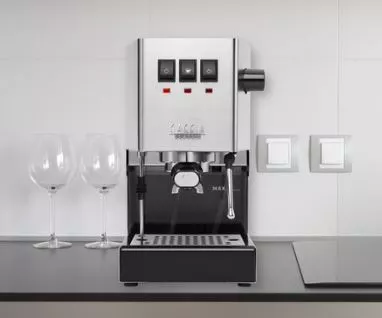

Check Price Gaggia Direct
Use Discount Code: COFBLCJ50 for £50 off!
Ends at the end of August. Includes the Gaggia Classic pro (fundamental stainless steel version) and all of the Gaggia Classic Pro + Coffee mill bundles.
Gaggia Classic Pro Review In a Nutshell – Updated 2022
As you’ll discover if you’re a normal reader, I tend to go on a little bit ;-). I’m literally passionate about coffee and about coffee machines, and as a result, I do end up writing a lot.
Although I don’t make apologies for this, what I do try to do is to create nutshell versions of my review posts for anyone who’s in a rush & doesn’t have half an hour to spend reading a review article. In this updated nutshell review for 2022, I’ll do my best to concisely tell you what I think about the Classic Pro in a way that should hopefully tell you really quickly, whether or not this might be the perfect espresso coffee machine for you.
Joint Best Espresso coffee Machine in the UK at This Price Point
Given that my goal here is to tell you as concisely as possible what I think about the Gaggia Classic pro, I think one of the best ways to achieve this is to tell you that at this price point, I think this is the joint perfect espresso machine on the market in the UK – at the time of writing in 2022, tied in 1st place for home Barista espresso machines at this price point, with the Sage Bambino Plus.
Sage Bambino Plus Review
These are two very different machines – and I do my best to explain the differences in this short video:
In a nutshell, the Bambino Plus has more features, it’s more user friendly, undoubtedly more beginner-friendly – the Classic Pro is extremely close to the original classic so there are no bells, whistles, airs, or graces.
The Classic Pro is built to last, and to be maintained and repaired over the years, while the Bambino Plus is more of a modern kitchen appliance in that you’re more than likely going to have it for at least the two years it’s under warranty, and then any additional year after this, is a bonus, essentially.
My older classic is currently 19 years old and going bold, and I can’t see any reason why you couldn’t expect the same sort of longevity with the new classic pro if it’s maintained well.
There’s simply nothing else that compares with these two espresso coffee machines at the time of writing, in my modest opinion, other than the mildly cheaper “Non-Plus” version of the Bambino which doesn’t have a solenoid valve and doesn’t have auto steaming however does have a steam wand on a ball joint and a hot water button.
If you’re fixed at this sort of price point, then I do think your perfect options are going to be Gaggia Classic Pro or Sage Bambino Plus.
The integrated mill options from Sage are likewise worth considering, but personally, I’d recommend a stand-alone espresso coffee machine and grinders if you’re getting into the home barista hobby. Dialing in can just be a little bit of a pain in the rear with the integrated grinder machines.
If you’re wanting a semi-auto (and the semi-auto bit, in case you were wondering, just indicates that it has a pump to create the pressure) manual espresso machine, for creating decent shots of espresso coffee, and well-textured milk, the Gaggia Classic pro is definitely among the best options.
It’s old school, it has an on/off button, a shot button, and a steam button – and a steam valve, and that’s yer lot.
You have to do some temperature surfing (which is extremely humble once you learn what you’re doing) as it doesn’t have a PID to control the temperature, but once you’re up to speed you can create some very nice espresso coffee with the Classic pro if paired with an espresso capable grinder.
Gaggia Classic Pro – Perfect Home Espresso Machine for Espresso Quality?
I get most emails from readers, and one of the the majority of common questions after the very common “Sage Vs Gaggia” matter – is which espresso machine produces the perfect espresso coffee between the Bambino Plus and the Gaggia Classic Pro?
It’s really impossible to give a simple answer to this seemingly modest question, as it’s far more complicated than it may sound. When it comes to espresso quality at this kind of price, I think both the Sage Bambino Plus and the Gaggia Classic Pro are about the best you’re going to get (unless you go for used or reconditioned) nevertheless which one is best, depends.
Primarily it depends on the user. In the hands of the total beginner home barista, I think the Sage machines take the lead. The PID temp control, auto low pressure pre-infusion & overpressure valve set to 9 bars make this machine perform incredibly well straight out of the box in lesser trained hands.
In the hands of the more seasoned home barista, even though, I think the Gaggia Classic Pro takes the top spot, due to the reality that, with a tad of modding and a bit of routine-based taming, the Classic in truth can perform outside of its weight class, and even more so with a bit more jiggery-pokery in the form of an aftermarket PID to allow the user to have more control over the brew temperature.
If you’re currently a beginning home barista, but you’re eager to hone your skills and take your home espresso as far as you can go, then I’d say you’ll get the a lot of mileage from the Gaggia Classic Pro, due to the fact that when you get to the point that your home barista chops outgrow the machine, you can do some modding to allow the Classic to take you further on your journey.
On the other hand, you could truly cut your teeth with the Sage Bambino plus and then upgrade when you outgrow it. You’ll probably get the old “upgradeitis” fairly soon anyway ;-). If you do plan on upgrading, although, it’s worth keeping in mind that the Gaggia Classic does tend to hold its appreciate quite a little bit better – so while you’ll pay about the same for them now if you upgrade in 2 years, I’d expect you to lose a lot less on the Classic if you sell it used than the Sage Bambino Plus.
Very, if the price of that much older Gaggia classics is anything to go by, I’d say that if you bought a representative now and sold it in ten years, you probably wouldn’t lose much on it at all unless you were to take inflation into account. For example, I’m looking at the lately sold items on eBay, and a twenty year old Gaggia classic recently sold for only £80 less than the brand new Gaggia Classic Pro retails for.
Gaggia Classic Pro – Best Home Espresso Machine for Milk Texture?
Milk texture is a similar story to espresso coffee quality, in that it depends on the user, even more so actually when it comes to milk texture.
The Classic pro with it’s actual brew boiler vs a thermocoil (or their version of a thermocoil which they call the ThermoJet), there’s the potential for better steam power and very similar effects but a little bit quicker, and I say “potential” because there’s more of a knack to steaming with the Gaggia Classic than there is with the Bambino Plus.
There’s a trick to steaming with the Classic Pro, which is just to turn the steam switch on and then only wait for around 7 or 8 seconds (it may take longer if you’re not in the UK, due to power differences) before opening up the steam to purge the wand, and then getting on with steaming the milk. Once you’ve got this down (you’ll simply need to find the sweet spot with your machine, it may be 9 or 10 seconds for example), it’s just a case of getting the hang of the jug position and so on.
See my Gaggia Classic Pro milk-steaming tutorial below, for more on this.
I’m Not Interested in the Home Barista Hobby – Is the Classic Pro For Me?
In short – yes, the Gaggia Classic Pro is literally as good a preference for the on a per day basis home espresso machine user as it is for the budding home barista.
The difference between the home barista and the more “normal” home espresso coffee machine user, is very hobbyist work with vs “means to an end” work with.
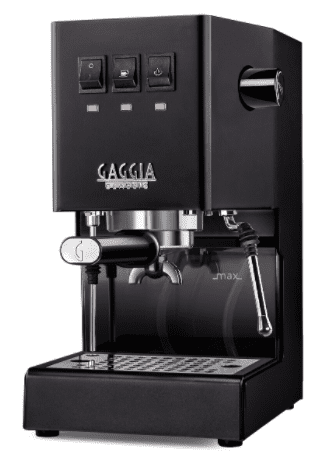

Check Price Gaggia Direct
In other words, home baristas are using an espresso coffee machine as a hobby, with the intention being to continually improve the quality of their espresso coffee and espresso-based drinks, while “normal” coffee drinkers might buy an espresso machine just as a implies to an end, that end just being espresso and espresso-based drinks.
Some may say that the home barista will enjoy better-tasting coffee than the “normal” home espresso coffee machine user, but I think that’s up for dispute, due to the fact that taste is such a subjective thing, and the palate is something that develops with barista skills.
So the untrained espresso coffee machine user with an untrained palate may be just as happy with the coffees they’re creating as the developing home barista with their developing skills and palate if that steeps sense?
So while the Gaggia Classic Pro is capable of being a home barista espresso machine, it’s also a popular preference one of normal home espresso machine owners who have an eye for more old-school retro design, and who like investing in machines that are built to last. While there is something about the Classic that makes it more appealing to home baristas than other entry-level espresso machines, there’s nothing about the Classic that steeps it a no-no for more “normal” home use.
The Classic Pro, as with the Bambino Plus, comes with pressurized baskets – which allows this machine to be used very much as a “normal” espresso coffee machine, with any coffee grinder, even with pre-ground coffee beans if you should, so don’t be fooled into thinking that just because you have no interest in the home barista hobby the Gaggia Classic isn’t going to be for you.
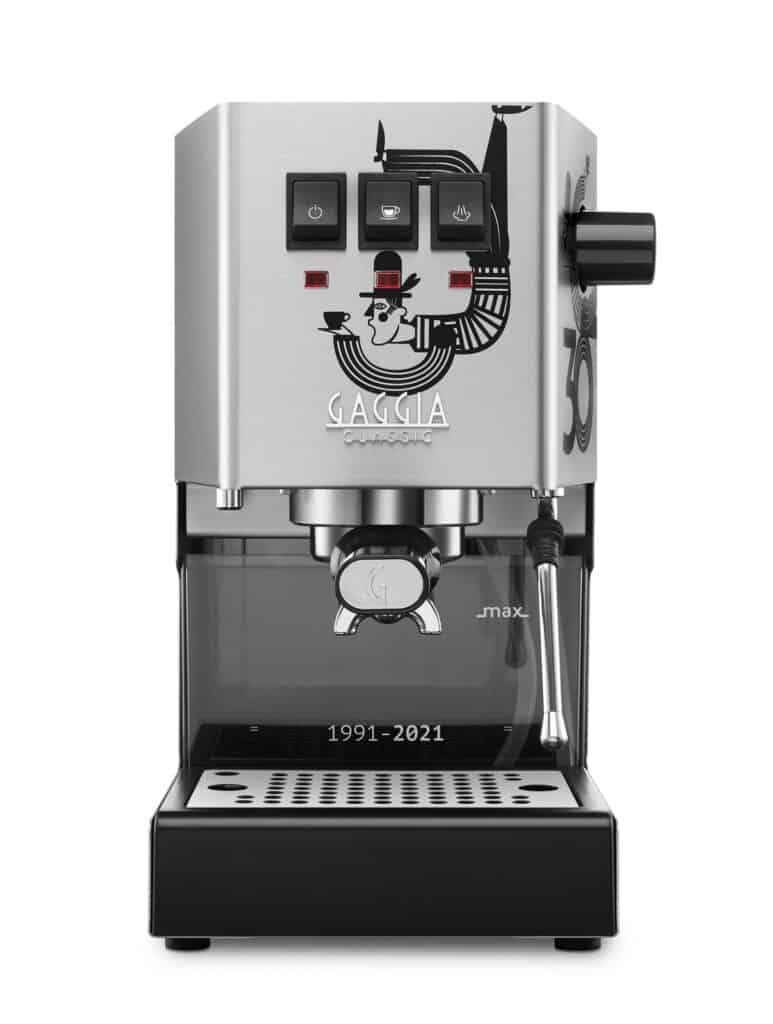

Check Price – Gaggia Direct (Work with Discount Code COFBLACR for £75 off!)
What are the Negatives?
There are always going to be advantages and disadvantages when buying any espresso machine, and literally keep in mind that though several people will think of this as an expensive espresso machine, it basically isn’t. I’ve read a few reviews on mainstream blogs that refer to the Gaggia Classic Pro as pricey. Wow, if they think this is pricey, they needs to check out the La Marzocco Linea Mini ;-).
The negatives, or quirks, of the Gaggia Classic Pro, are of extremely little significance to the “normal” daily espresso coffee machine user, and won't be of significance for long for the home barista. I say this due to the truth that the quirks of the Classic are generally in the form of temperature instability issues.
If you’re a home barista and you’re trying to get the extremely perfect extraction from each shot, you’ll learn your way around this quirk in no time, with temperature surfing, and if you’re utilizing it as a standard coffee makeking equipment user, you’ll probably not even discriminate between a shot which pulled at the great brew temp for the coffee you’re using and one that was too hot or too cold, especially if you’re utilizing the pressurized baskets.
If you class yourself as more of an each day coffee machine user rather than a home barista but you like to think you have a ideal palate and you’ll know if the shot has been pulled too hot or too cold, then simply find out to temp surf, it’s not that much of an matter in truth. Just keep in mind even though that no amount of skill will enable you to get wonderful effects from bad coffee, and on that note, here’s a shameless plug for my own, amazing quality (I’m not going to say it’s crap, am I?) freshly roasted coffee beans.
Utilize discount code CBNC25 for 25% off your first order at Coffeeworks
So there you go, that’s my “nutshell” version of my Gaggia Classic Pro review. By the way, if you’re reading this now and you think I missed some information that you’d have liked to have seen covered in this shortened version of the review, please let me find out in the comments below, or drop me an email – Kev at coffeeblog.co.uk.
Gaggia Classic Pro Review – The Longer Version
Released in 1991, the Gaggia Classic was an incredibly popular home Espresso machine and remained largely unchanged (why troubleshoot what isn’t broken?) until 2009 when Phillips took over Gaggia & things began to alter.
The original Gaggia classic was crafted in Italy, had the 3 way solenoid valve, all brass group, and full sized 58mm portafilter, and truly was built to last.
This is shown by the reality that there are still in 2022, so a number of of the pre 2009 original classics still going strong, it extremely was a stonking machine for the money.
The only thing this comparatively low-cost espresso coffee machine was lacking when it came to home barista work with, was a proper steam wand.
Nevertheless after 2009, things began to change, they “messed” with a machine that most users agree didn’t need to be messed with.
This came to a head with the 2015 model.
This version of the classic had push buttons instead of rocker switches, a mechanical valve instead of the 3 way solenoid valve, a couple of plastic bits that were previously metal, lower power, and a panarello steam wand that was much more difficult to adjust.
The New Classic Kicks the Old Classic’s Ass?
When I say the new classic is better than the old classic, I’m not talking about the original pre-2009 Classic.
I’m referring to the versions after 2009 up until the new 2019 classic, and especially the 2015 model.
Actually, the Gaggia classic 2015 was really similar to the Gaggia Coffee, which was a different espresso machine from Gaggia which came with a mechanical valve.
I’m unsure why Gaggia didn’t call this the new Gaggia Coffee and keep it as a slightly lower cost choice to the new Gaggia Classic Pro, I would think it would sell well – and in my opinion, this machine would serve a mildly different market, but I digress.
See my comparisons on youtube:
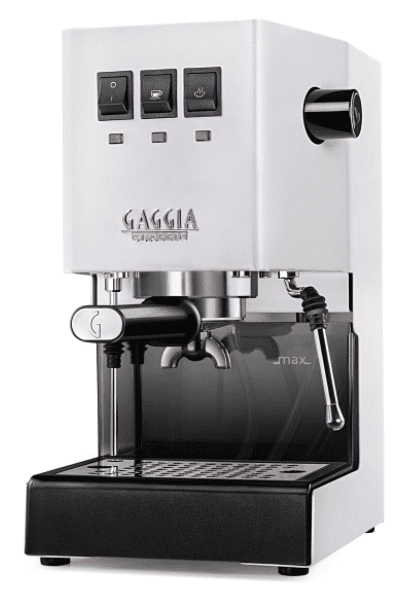

Check Price Gaggia Direct
The 3 Way solenoid Valve
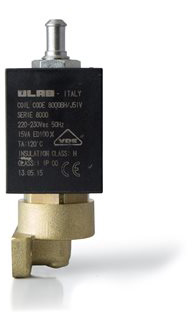

Above, is the important 3 way solenoid valve.
The majority of home barista Espresso coffee machines work with among these, to release the pressure from the brew head after pulling the shot.
The majority of cheaper, domestic espresso coffee machines lack a 3 way valve, which is why they tend to produce sloppy pucks that aren’t as satisfying to knock out of the portafilter, by the way.
Previous models had a mechanical valve to do this instead of the solenoid, which aren’t quite as good at doing the job, but which require less maintenance.
The lack of the proper solenoid valve on the newer models after 2009 is among the main reasons why the general consensus about these models of classic has been: They don’t make them like they used to!
And I agree with that, up until the Gaggia Classic Pro!
Then what happened?
It appears, that Gaggia listened to their customers!
They crafted the new Gaggia Classic Pro – or “2019”, which wipes the floor with the 2015 model, for the following reasons.
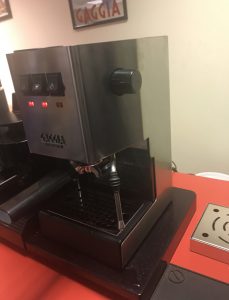

The new Gaggia Classic Pro or “2019”:
- Is Made in Italy again.
- Features the famous solenoid valve that was missing on earlier models
- Has lost the bits of plastic
- Has some other improvements (which I’ll get to shortly)
and…
Features a professional steam wand!
This for me is a big deal.
Call me sad, I don’t care ;-).
The one thing that I feel always kept the classic within the domestic/consumer Espresso machines category, was the reality it comes factory fitted with a Panarello steam wand. Other than this, I’ve always seen the Classic as a prosumer home barista Espresso coffee machine.
It has a proper boiler, not a thermocoil or thermoblock.
It has a full sized (58mm) metal (chrome plated brass) portafilter, a decent sized water tank, decent sized drip tray, everything about it has always said home barista, to me, except the steam wand.
So the truth Gaggia have finally noticed, after numerous years that lots of people who buy the classic, mod it with a Rancilio steam wand, and decided to factory fit a pro steam wand – is great news!
I spoke with Raj Beadle, the owner of Caffe Shop Ltd, Gaggia distributor in the UK (he was the MD of Gaggia UK until the Phillips takeover), to see if I could get a loan unit for a week or so to work on a user review.
At first, I couldn’t get hold of one as they’d all sold out (which is an very common occurrence now, with the Classic pro and many other decent espresso coffee machine, thanks to the current situation).
However a little later on, they had some in stock, they sent me one – and I spent some time with it.
Now Available in Colour


Gaggia direct have recently launched the new Classic Pro in the UK in various different colours.
They’re almost the exact same machine, but with a coloured body. I say almost the exact same machine, due to the fact that the metal the body is made from is zinc coated steel, galvanized steel, vs stainless steel used on the standard model.
One of the things the classic is known for is not rusting.
Other machines such as the La Pavoni Europiccola, and the Rancilio Silvia, are known from suffering from rust issues over time, and this is one pro that the classic has over lots of other similarly priced machines, it basically doesn’t rust.
Galvanized steel does have a protective coating against rust, it’s dipped in zinc and that coating will protect it from the elements which allow rust to develop.
In theory though, while stainless steel which is formed by mixing steel with chrome while molten, has inherent rust protection, galvanized steel has a protective coating, and coatings can wear.
So while I like the look of these coloured classics, being totally honest I think if I was investing in a new Gaggia Classic, I’d stick to the tried and tested rust free stainless steel Classic rather than take my chances with the coloured version.
I may be entirely wrong, they may turn out to be totally rust resistant, nevertheless we won’t discover for a good few years.
What grinding machine?
The Sage smart coffee grinder pro is a popular option for pairing with the Classic, it’s a good preference in my opinion, it’s very user-friendly, and it’s truly good for espresso coffee and for all manual brew methods.
Sage Smart Coffee grinder Pro Review
If you have a mildly bigger budget, but, the Eureka Mignon range is well worth considering, and my favourite is the Specialita, which has the mildly larger burrs and two programmable doses.
Gaggia Direct have a wonderful deal on, at the time of writing, for the limited edition Acrobat version and the Mignon La Specialista:
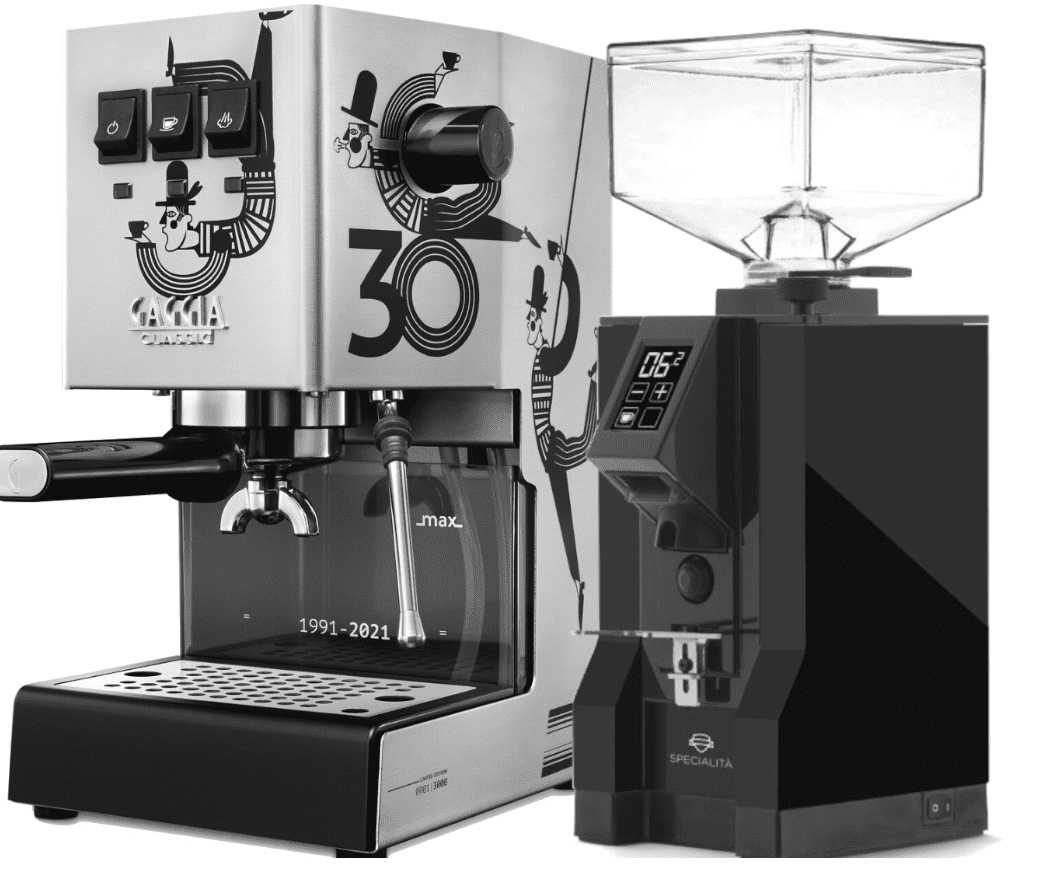

Check Price Gaggia Direct
For more options, see my best coffee grinders review:
Perfect Burr Grinders
Literally before we go back to the Gaggia Classic Review, I basically wanted to point out that Gaggia Direct are currently offering an extra 1 year warranty free of charge, so you’ll get a 3 year warranty with the classic if you get hold of one while this offer is still valid.
Click here to check, just look on the right hand side of the product page, if the extra year warranty is still being offered you’ll see “2 years +1” under “Warranty”.
Gaggia Classic Pro Review.
I think I need to point out that we’re talking about the latest (at the time of writing) 2018/2019 model known as the Gaggia Classic Pro.
Be really careful if you’re buying this from anyone but gaggiadirect.com, as there are others who appear to be selling the 2015 version as the “2018” based on the manufacture date, however basically being manufactured in 2018 doesn’t make it the new 2018-19 “pro” model.
Likewise, if you do appear to be getting a fantastic deal on a Gaggia machine (or any other machine), I’d suggest doing a bit of Googling to ensure that you are literally buying a machine from within the UK, with UK warranty.
There are firms who claim to be selling UK stock, who aren’t.
If you’re uncertain, just google the name of the website you’re looking at, plus “trust pilot” and you’ll be able to read reviews for that supplier, click on the negative reviews and simply check for anyone complaining that the machine came from Italy or Poland, with a 2 pin EU plug, etc.
They don’t make them like they used to… they make them even better!
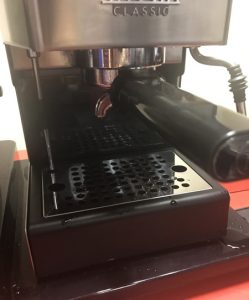

Check Price – Gaggia Direct
Work with Discount Code: COFBLCJ50 for £50 off!
Ends at the end of August. Includes the Gaggia Classic pro (standard stainless steel version) and all of the Gaggia Classic Pro + Mill bundles.
I know it may seem strange to put the conclusion of a post towards the starting, but I thought this may be useful for anyone who just wanted to quickly find out what I thought, overall, of the new Gaggia Classic Pro 2018/19.
And that is, in my simple opinion, it is not extremely as good, nevertheless even better, than the highly acclaimed original Gaggia classic.
To quickly explain why I’ve come to this conclusion – and I’ll get into more detail shortly – but in a nutshell:
It has the 3 way solenoid valve, and everything else that was fantastic about the original, nevertheless it likewise has the professional, factory fitted steam wand.
It heats up in about 45 seconds.
There’s a lower profile drip tray available, it’s easier to see the water degree in the tank, and I think just the rounding off of the front of the basic drip tray makes the new classic slightly more aesthetically pleasing.
So if that’s all you wanted to know, then there you go, go get one from gaggiadirect.com.
Anyway, to continue with the new Gaggia classic review:
Appearance
On the face of it, the new 2019 Gaggia Classic Pro looks really similar to previous models.
The front edge of the drip tray is rounded off which I think is a beneficial thing, it’s only a small touch nevertheless I think it makes the machine look slightly more modern. The pressure overflow pipe has an anti burn cover on it, as does the new pro steam wand.
There’s a slight cut-out on the side of the metal framework which gives you another way to view the water tank extent, which again I think is a positive change.
The steam and coffee buttons have swapped positions, which may throw you a little initially if you’re used to the older models.
Other than these small details, it’s extremely obviously the Gaggia Classic in appearance.
Dimensions
The dimensions haven’t changed, nevertheless I have seen various different dimensions reported, so these Gaggia Classic Pro dimensions I’m giving are from simply measuring the one I’ve got here:
36cm tall
19.7cm wide
23.8cm deep
I realize that the 36cm I’m quoting is a couple of CM less than the 36cm you’ll see on various websites, so I’m uncertain if some have been crafted with taller rubber feet. The one I’ve got is 36cm with the rubber feet, and if you need it to be mildly shorter, you can remove the rubber feet and that takes it down to about 35cm.
The solenoid valve is back
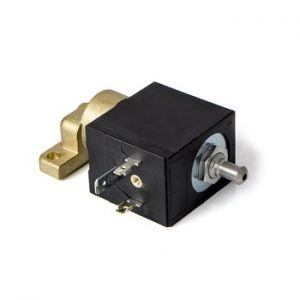
 Some other models, including the more recent 2015 version, had a mechanical valve instead of the 3 way Solenoid valve.
Some other models, including the more recent 2015 version, had a mechanical valve instead of the 3 way Solenoid valve.
Extremely, switching to a mechanical valve crafted sense on paper.
Though they’re not as powerful, they basically require less maintenance than solenoid valves. If you live in a harder water area, it’s a bit more important to keep on top of descaling with a machine with a solenoid valve vs a mechanical valve.
But, the people spoke, they wanted the power of the good old solenoid, and Gaggia listened ;-).
Truly, the new solenoid valve is mildly smaller than the older ones, however I’m told it’s basically as powerful, and that size doesn’t always matter…
Aluminium boiler
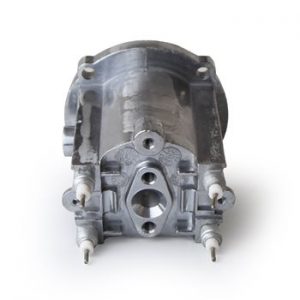
 Speaking of size, the 2015 classic featured a larger (200ml vs 130ml), stainless steel boiler. The new 2018/19 version has gone back to the smaller Aluminium boiler.
Speaking of size, the 2015 classic featured a larger (200ml vs 130ml), stainless steel boiler. The new 2018/19 version has gone back to the smaller Aluminium boiler.
Anodised Aluminium
As far as I can tell, the Aluminium boilers on the classic pro is anodized.
I’ve found this difficult to get an exact respond to on, nevertheless I believe it is anodized, meaning there’s a coating to ensure that the water in the boiler isn’t coming into direct contact with the Aluminium.
One thing to add, even though, is that if you do live in a harder water area, it is important to keep on top of descaling.
This isn’t just to look after the machine, however in theory, limescale can cause pitting on the surface of the boiler, this can, in theory, cause damage to this coating over time, allowing the water to come into direct contact with the Aluminium.
Another thing to note is to make sure you’re utilizing the proper descaler.
Some people use different kinds of descaler, which can likewise damage this coating.
Gaggia create a descaler which is made specifically for their domestic machines, so It’s worthwhile using this – or at least contact them to ask if the descaler you’re planning on using is compatible, and isn’t going to cause any damage.
Gaggia Descaler Liquid
Faster warm-up time
One of the benefits of the smaller, Aluminium boiler vs the larger stainless steel boiler that previous versions have used, is that the new Classic heats up quicker, at around 45 seconds (I’m assuming the increase power helps in this regard too, but more on this shortly).
Smaller boiler, less steam power?
The larger boiler size would naturally provide more steam power, however in reality, I am impressed with the steam power on the new classic.
As you’ll see if you watch my steaming tutorial above, there’s a trick to getting the best from the small boiler.
All you do is start the steaming after around 7 or 8 seconds from turning on the steam, instead of waiting for the machine to indicate that the steam is ready.
If you do this, you’ll have plenty of steam power to appropriately texture enough milk for one or two milkies.
The new professional steam wand.
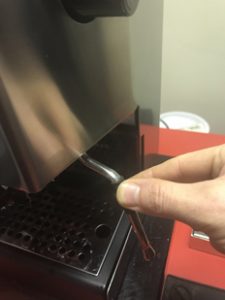

Yes, I find out I’m going on about it ;-), nevertheless among the reasons I think this model is better than previous versions – is it comes factory fitted with a proper, professional steam wand.
For me, a machine with a Panarello wand is a basic domestic Espresso coffee machine.
Home Baristas need full control over the steam, for creating a wide range of different drinks, not just the thick cappuccino foam that a Panarello will provide.
The new steam wand does look really similar to the Rancilio steam wand that people have been utilizing to mod their Classics for years – nevertheless the biggest difference is that it has a two hole tip as opposed to a single hole steam tip.
The idea of having more than one steam hole is that it helps to get the milk spinning, and to distribute the micro-foam throughout the milk.
The water tank
Not much to say about the water tank in fact vs the other models, it’s the same large 2.1L capacity water tank.
The only thing to note is that I did often find it difficult to tell what the extent was by looking at the tank, probably due to the lighting in our kitchen.
The new design of the metal frame includes cutouts on the edge, enabling you to see the water degree there too, which I think is a nice little touch.
The drip tray
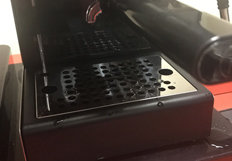

The drip tray on the new classic has a rounded off front edge, which I think is a slightly nicer look.
They also now offer a nice looking low profile all chrome drip tray, which is a good idea for anyone who likes to pull their shots directly into taller cups quite than using shot cups or glasses.
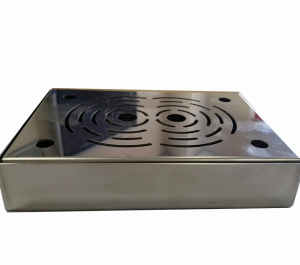

All brass group & portafilter
The older versions of the classic featured an all brass group head, and all chromed brass portafilter (except the handle of course). The 2015 version contains some plastic to aid the locking of the portafilter into the group, the new Gaggia Classic Pro doesn’t have this, it’s all metal.
Metal splitter
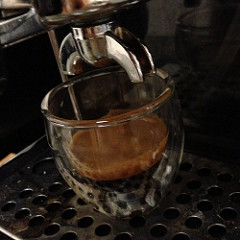
The splitter on the bottom of the portafilter, which does the job of separating the Espresso coffee flow into two sides, is metal on the original versions, but the 2015 version came with a plastic splitter.
On the Gaggia Classic Pro, I’m happy to see that they’ve switched back to the metal splitter.
Traditional baskets and pressured baskets
There are two types of baskets you can work with with Espresso coffee machines, pressurised or “perfect crema” baskets, and traditional baskets.
Pressurised baskets were developed to aid domestic Espresso machine users to generate the pressure in the basket to create better Espresso coffee.
A lot of domestic machines come with pressurised baskets, while home barista machines, and commercial Espresso coffee machines, will always come with fundamental baskets.
The new classic comes with both pressurised baskets, and single baskets.
So if you have no interest in catching the home barista bug, and you want to basically buy pre-ground coffee rather than also buy a mill and grind your own beans, then you’d utilize the “perfect crema” pressurised baskets, which will help you to get better impacts from pre-ground coffee.
You may consider yourself to be a home barista, as I do.
This means you want to do everything yourself including grinding the beans, spending the time to dial in the grind for each bean, before dosing and tamping the coffee into the portafilter.
In this case, then you would work with the standard non pressured baskets, and work with the excellent crema baskets as mini frisbees, or something.
Truly, probably a good idea to keep them for when someone (it’s the thought that counts) buys you pre-ground coffee as a gift, so you can at least utilize it if you run out of coffee beans ;-).
You may just be considering buying the classic purely due to the fact that you want a fantastic Espresso coffee machine, and you have absolutely no interest in taking up a new hobby.
In this case, you’d reach for the pressurised baskets (make sure you don’t lose the small pressure pin that will be in the bag with the baskets, you’ll need that) and put the basic baskets away for a rainy day.
The buttons

The buttons on the pro model have gone back to the more traditional rocker type switches as opposed to the more basic buttons on the 2015 model.
The new buttons look more like the older models – with one major difference, literally for a prank, they’ve swapped the position of the coffee button and steam button ;-).
It might not be a prank, but I’m uncertain what another goal there would be for doing this.
It doesn’t very make much difference other than the truth it may throw you a bit until you’re used to it if you’ve had among the older models of the classic for years.
Another change re the buttons is that each one has its own light.
It used to be that there was one light above the power switch, and one above the steam which was the light for both the coffee button and the steam. There’s now a separate light for each.
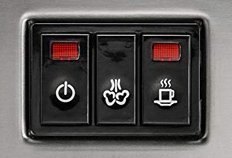
While the 2015 version had push button switches, the 2018/19 pro model has the rocker switches that we’re used to seeing on the classic.
The power button is a spring loaded rocker switch which actuates a relay. The steam and coffee switches are the same traditional rocker switches you’ll be familiar with if you have used one of the older models.
Auto off
The reason for the alter to the push buttons on the 2015 model, and the reason that the power switch on the Gaggia Classic Pro is a spring loaded rocker activating a push button relay switch, is the necessity for the auto off feature.
The 2015 model automatically turns off after 9 minutes. With the new classic pro, this has been extended to 20 minutes.
This is thanks to EU regulations (see EU rules force coffee machines to switch off) which came into force in 2015 and apply to most kitchen appliances, not literally Espresso machines.
Coffee machines & other appliances can’t be sold with the EU which don’t have an auto cut off function. This may well alter now we’ve Brexited, watch this space.
I don’t think this auto off thing is a big deal for Espresso coffee machines, even though. At least not for a machine like the classic which heats up quickly.
The boiler water is in reality up to temp with the new Gaggia Classic within around 45 seconds.
Some people (I did too when I first bought my Gaggia classic a few years ago, I think I’d read it in a forum thread) seem to think that they need to leave the machine to heat up for 15-20 minutes, however this is a little of a misconception.
You can very start brewing with an Espresso machine literally about as soon as the brew temp is reached.
The only question at this point is that the other parts of the machine including the group and the portafilter, won’t be up to the desired temp and the flowing Espresso coffee with the first couple of shots would be cooled down as a result.
So all you need to do in order to help bring the other parts up to temp is to run some hot water through the group with the portafilter inserted.
The cup, or both the shot cup or glass and the coffee cup (if you pull the shot into a shot glass or cup and then decant into a larger cup) should be warmed too, to prevent the espresso being cooled down by hitting cold ceramic or glass.
So, for example, if you pull your shot directly into your cappuccino cup, you can fill up the cup with hot water from the group head, with the portafilter inserted, to heat everything up at the same time.
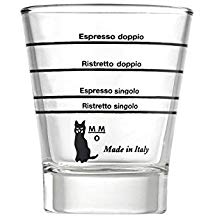

If, like me, you pull your shots into a small shot cup or glass & then pour this into your larger cup (my cups don’t fit under the portafilter, though they may do with the lower profile stainless steel drip tray that is now available as an optional extra) if your shot glass will fit inside your bigger cup, you can put it inside the cup, and warm both cups up at the same time while warming up the group head and portafilter.
Power
The original classics were 1425 Watts, including my 2003 model.
After the Phillips takeover, the power dropped to 1300W, so not a huge drop, however the 2015 model dropped still to 1050W.
The new model is back up to 1300W. While I assume that this, coupled with the smaller Aluminium boiler is why the pro heats up quicker than the 2015 model, I doubt it steeps a huge deal of difference.
Other well respected and more expensive home barista Espresso coffee machines have a similar wattage to the 2015 model, including the Rancilio Silvia (about £425) & the Nuova Simonelli Oscar 2 (about £700), which is what makes me say this.
OPV (Over Pressure Valve)
The OPV on the original classic could be adjusted in order to fix the brew pressure.
The OPV on the Gaggia classic pro is fitted to the top of the pump and is factory set, it can’t be adjusted.
So that the classic pro can conduct for both standard and pressured baskets, the new classic comes set at about 12 bar.
In order to tweak this down to the fundamental 9 bar, if you see fit, there’s an extremely cheap and modest mod you can do. Basically get hold of a spring mod and instructions, and just change the spring, or change out the OPV valve for one already fitted with the 9 bar spring. This will cost you about a tenner.
Price
Check Price – Gaggia Direct
There are two main markets for manual Espresso machines. The fundamental domestic market & the home barista market.
The domestic market consists of every day coffee drinkers who just want to make the perfect espresso they can, with a machine they can afford.
The home barista market consists of people who see coffee as a hobby, and are happy to invest a considerable amount of time and money into upgrading their skills and their equipment, to gain a continual improvement in the quality of the coffee they’re able to make.
The classic has always straddled these two markets, as a top end manual semi auto Espresso coffee machine for the basic domestic market, and as an entry-level home Barista machine.
To the uninitiated, the cost of the Classic Pro may seem a heck of many money for an espresso coffee machine.
Extremely, it’s a relatively affordable espresso coffee machine – as far as home barista machines go.
It’s among the cheapest espresso machines to be regarded as entry-level home barista machines.
Other single boiler machines such as the Rancilio Silvia are around a hundred quid more, and it’s all uphill from there.
Once you get to heat exchanger machines you’re talking around a grand upwards, and you can easily get into the 2-3k territory or even higher if you wish, with some of the higher-end dual boiler machines.
Single Boiler Vs Heat Exchanger Vs Dual Boiler
It does cost more than previous Gaggia Classic models did.
Nevertheless don’t forget, after 2009 and until now – the Gaggia Classics weren’t in reality Gaggia Classics. They were cheaper machines in the Gaggia classic shell, more or less.
So it does make sense now that we’re almost back to the original classic, that it’s going to cost a bit more.
Want an original classic however have a much smaller available budget?
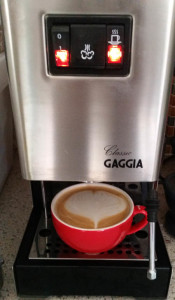

I understand some new budding home baristas will be reading this who don’t have the budget for the new classic, and this was me when I bought my classic a few years ago.
If this is you – then why not do what I did, look for a used pre 2009 classic, these machines are practically the same as the new 2018/19 machine. That’s my 2003 model above, just after I’d bought it and modded the wand.
Gaggia Classic Old Model – My Review
Yes, you may find that a used machine needs some TLC, but if you’re careful enough to read the descriptions appropriately, look at all of the images, and ask questions if you’re unsure (you may want to ask if it has had typical maintenance such as descaling) you ought to be able to find a machine with no issues.
I ended up picking up my 2003 model, which was pristine, with absolutely no problems with it, for £100 on eBay.
A tip to help you find an original is to look at the badge.
If it has an etched logo like mine does, on the photo on the left, then it’s definitely a pre-2009 model.
If you see one with a stuck-on badge, as per the photo over on the right, it may be a post-2009 model. If the seller hasn’t specified the date, simply ask them to look at the sticker on the bottom, with the manufacture date.
A tip when it comes to limescale is to check where the item is and google to see if this is a hard water area or a soft water area. If you can get a machine from a soft water area (as I did) there’s a lot less chance that the machine will be suffering from any limescale issues.
Is the Gaggia Classic Pro still an entry-level home barista machine?
For me, the new Gaggia classic is definitely a machine for home baristas – as well as being absolutely fine for the more “normal” home espresso coffee machine user who wants a more old school machine that are built to last.
When you look at the build quality, the truth it has the 3 way solenoid valve, the power rating, the reality it has a pro steam wand – it’s no less a potential home barista espresso coffee machine as the original Gaggia Classic, simply with the addition of the pro steam wand I think the Classic Pro is an even better option for home baristas than the original, as you don’t need to mod the steam wand.
Is Gaggia Classic Pro worth it?
In short, definitely. This is an old-school semi-automatic espresso coffee machine, with a proper brew boiler, 3-way solenoid, and pro steam wand – which is extremely easy to repair and maintain.
It wouldn’t surprise me if these machines end up lasting literally as long as the original classic, which can be decades. There are plenty of machines from the early 00s and even earlier still going strong, including mine from 2003.
So is it worth the cost, when weighing up the quality of the coffee the Gaggia Classic Pro can produce, and the length of time it’s likely to carry on doing this for, I think it’s safe to say it is definitely worth it.
However I don’t like the “is it worth it” issue in general, it’s a widely asked issue but it never really brews much sense. Whether anything is “worth it”, in truth depends on what perspective the issue is being asked from.
I think where this sort of matter stems from is when there are cheaper alternatives, and to address this matter properly I’d need to know specifically what alternative is being discussed.
If you’re asking if the Gaggia Classic Pro is worth spending extra money on vs the Gaggia Classic 2015 for example due to the fact that you can sometimes get the 2015 quite a bit cheaper – I’d say yes.
I don’t view the 2015 as rather being the classic, it’s among the the majority of versions of the classic from 2009 – 2019 which was a little bit of an imposter. Lots of of these models were impressive for the price, being honest, but I do believe that the Classic pro which has gone back to its routes, is worth the extra cost vs these earlier versions which came about after the Philips takeover.
If you’re asking if the Gaggia Classic Pro is worth more than other cheaper espresso coffee machines, such as the Swan Retro, Cookworks espresso coffee machine, DeLonghi Dedica, and so on, in general, the respond to to this in my humble opinion is usually yes, though the reasons for this are too several and too complex to address here. If you want a specific answer relating to another specific machine, literally drop me an email and I’ll reply to you directly.
Why buy Gaggia machines from Gaggia Direct?

When shopping online, most us tend to buy based on price alone, as if price is the only thing to be concerned with.
Nevertheless when purchasing an electrical appliance such as an Espresso machine, we in fact need to think about who the after-sales support and service will be handled by, and what type of experience we’re likely to have when it comes to it.
I don’t think a lot of people would choose to save a few quid on a machine if they discovered that this UK was shipping directly from Italy, or from Poland, would extremely take over a week to come, and wouldn’t have a UK warranty.
Unfortunately, some people find this out when it’s too late.
Gaggia Direct (Caffe Shop Ltd) based in Elland, near Halifax are basically Gaggia UK.
When Phillips took over in 2009, Raj Beadle was the Managing Director of Gaggia UK.
In order to keep the company going, and keep his team in tasks, Raj formed Caffe Shop Ltd, bought the business including the Gaggia shops, and continued to run Gaggia Direct via the new company, as the sole UK distributor for Gaggia Milano.
From what I’ve seen when I’ve visited their offices, these are people who in fact care about their customers and actually understand about their products, and it’s no wonder this is the case, given that they are Gaggia UK when all said and done.
The last time I was there, Raj was taking support calls as the main customer support person was out of the office, and this is someone who clearly knows the Gaggia machines inside and out.
The engineer I met there, who had a look at my 2003 classic for me (which I’ll come to shortly), told me he’d been with them since 1989 – and his level of experience with these machines was clear when he knew just from the sound that my steam knob was creating when being turned, that the steam valve required replacing.
If you’re buying based on price, and you find a deal better than Gaggia Direct, I’d literally recommend that you spend 5 minutes checking trust pilot reviews, Google & Facebook reviews, you may well save yourself some potential aggravation.
The end…
There’s no need for a conclusion, truly, as I opened with it.
Basically, I think the new Gaggia classic pro 2018/19 is even slightly better than the original, and I think as long as you’re either buying it directly from Gaggia Direct, or from among their re-sellers (so you have a proper UK warranty with Gaggia direct themselves) then you can’t truly go wrong.
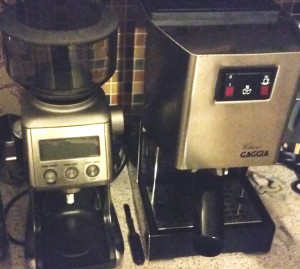
The only other thing to note is that Gaggia Direct will repair and recondition older machines. I didn’t realise that when I went, nevertheless as luck has it, we had been decorating the kitchen, and my 2003 classic which had been sitting in a box in the kitchen for a while, truly happened to be in the boot of my car!
I’d in reality given my classic a run for its money over a period of nearly two years.
I’d repaid it at times like a commercial machine, pulling shot after shot, and steaming jug after jug for latte art practice.
Water had begun to drip from where the wand connects, and I was intermittently getting some poor shots, and the odd extremely sloppy puck, so I just thought I’d run it into the ground.
I boxed it up and thought maybe I might look at trying to repair it one day, however it had been there for probably a year now, so I was beginning to think I’d never do anything with it.
It was in my boot as there was nowhere else for it while the kitchen was being painted, and I was in reality considering just offering it away to someone who reconditions machines, or worse still – taking it to the tip…
When I pointed out to Raj that my classic was in my boot, he very kindly asked me to go get it so he could ask among the engineers to have a quick look.
The engineer knew from the sound the steam knob was making, that the steam valve probably needed replacing, and he thought that the group seal probably essential replacing too.
So I left it there and asked them to just give me a shout to let me understand what the damage would be to fine-tune. Just a day or so later I got an email to let me learn that it was all done, the steam valve was replaced, a new seal had been fitted, and they likewise found it essential a new thermostat.
The cost for all this – £85, which I think is wonderful!
Check Price – Gaggia Direct
Life is like a box of chocolates, so join my Brew Time list, subscribe to my YouTube Channel, become an accredited coffee botherer (Patreon supporter), try my coffee at The Coffeeworks (use discount code coffeebotherers), follow me on Twitter & Instagram, follow the coffeeblog FaceBook page, and that’s all I have to say about that.
This article firstly appeared at Coffee Blog – The UK Specialty Coffee Blog – For Lovers of GENUINE Coffee!
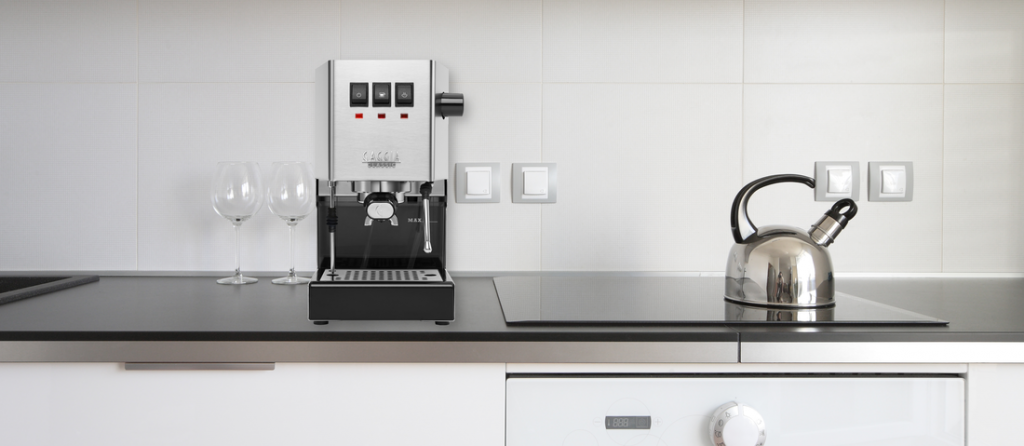
You must be logged in to post a comment.